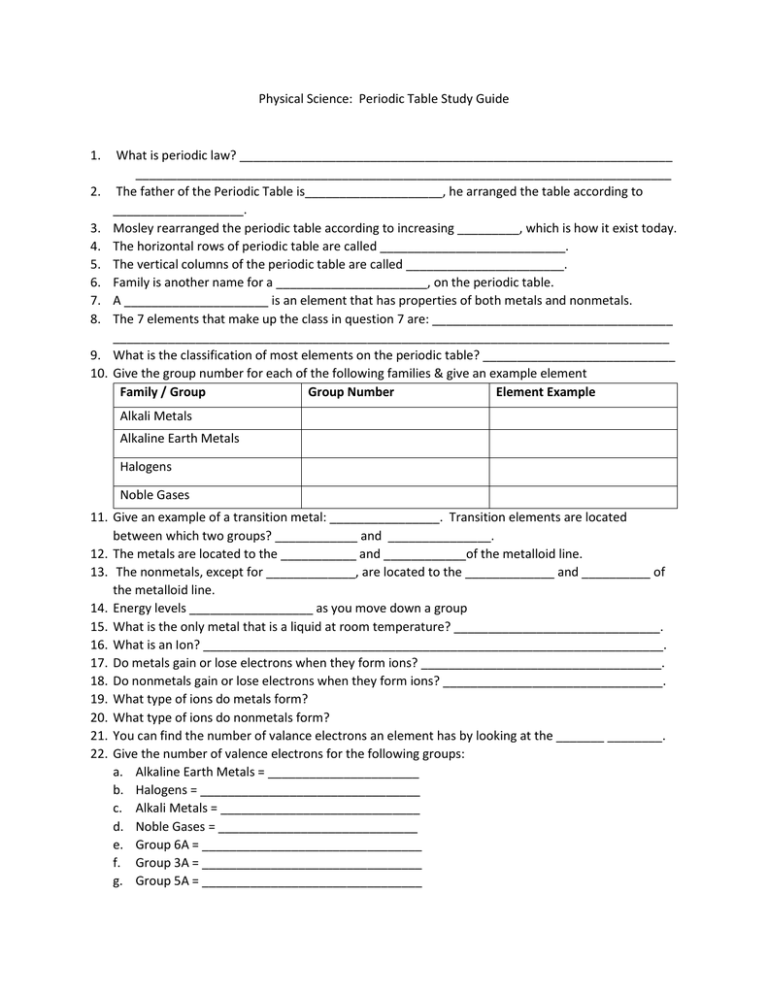Physical Science: Periodic Table Study Guide What is periodic law
advertisement

Physical Science: Periodic Table Study Guide 1. 2. 3. 4. 5. 6. 7. 8. 9. 10. What is periodic law? _______________________________________________________________ ______________________________________________________________________________ The father of the Periodic Table is____________________, he arranged the table according to ___________________. Mosley rearranged the periodic table according to increasing _________, which is how it exist today. The horizontal rows of periodic table are called ___________________________. The vertical columns of the periodic table are called _______________________. Family is another name for a ______________________, on the periodic table. A _____________________ is an element that has properties of both metals and nonmetals. The 7 elements that make up the class in question 7 are: ___________________________________ _________________________________________________________________________________ What is the classification of most elements on the periodic table? ____________________________ Give the group number for each of the following families & give an example element Family / Group Group Number Element Example Alkali Metals Alkaline Earth Metals Halogens Noble Gases 11. Give an example of a transition metal: ________________. Transition elements are located between which two groups? ____________ and _______________. 12. The metals are located to the ___________ and ____________of the metalloid line. 13. The nonmetals, except for _____________, are located to the _____________ and __________ of the metalloid line. 14. Energy levels __________________ as you move down a group 15. What is the only metal that is a liquid at room temperature? ______________________________. 16. What is an Ion? ___________________________________________________________________. 17. Do metals gain or lose electrons when they form ions? ___________________________________. 18. Do nonmetals gain or lose electrons when they form ions? ________________________________. 19. What type of ions do metals form? 20. What type of ions do nonmetals form? 21. You can find the number of valance electrons an element has by looking at the _______ ________. 22. Give the number of valence electrons for the following groups: a. Alkaline Earth Metals = ______________________ b. Halogens = ________________________________ c. Alkali Metals = _____________________________ d. Noble Gases = _____________________________ e. Group 6A = ________________________________ f. Group 3A = ________________________________ g. Group 5A = ________________________________ 23. Fill in the following table: Characteristics of Metals Characteristics of Nonmetals 1. 2. 3. 4. 5. 24. What are the four groups of metals? ___________, ___________________, ___________________, and ______________________________________. 25. Which group of metals is the softest and most reactive? ____________________________. 26. What are the two main groups of nonmetals? __________________ and _________________. 27. Which group of nonmetals is the most reactive? ___________________________. 28. Which group of nonmetals are colorless, odorless, and inert (nonreactive)? ___________________. 29. Which group of elements contain a full valence shell? _____________________________________. 30. Write the Chemical formula (symbol + ionization number) and name for each ION. Element ION Name of Ion Na O F Al 31. Metals increase in hardness as you move __________________ to _________________ across the periodic table. 32. Define valence electrons. ____________________________________________________________. 33. The semi metal that is in period two is ___________________________. 34. Which group of metals is the most reactive in water? ____________________________. 35. Which group of elements tend to form salts and are called “the saltmakers”? __________________. 36. How many valence electrons does and atom need to become stable _________________________. 37. The exception to number 36 is ___________________, which only needs two. 38. Elements in the same ________________________ share similar properties. 39. How many elements are in Period 5? ______________. In Period 6? ________________________ 40. What charge is a cation? ________________ What charge is an anion? _____________________





